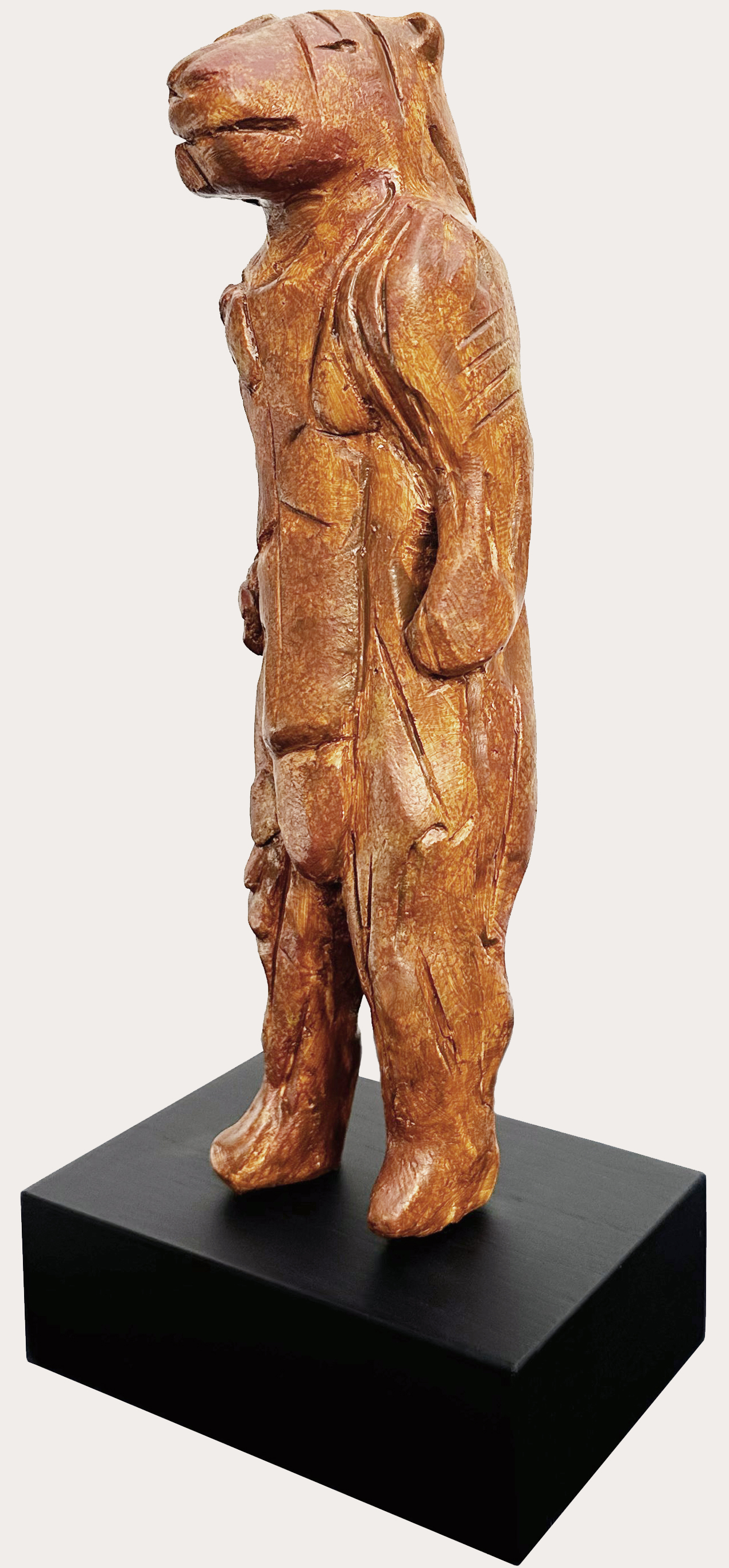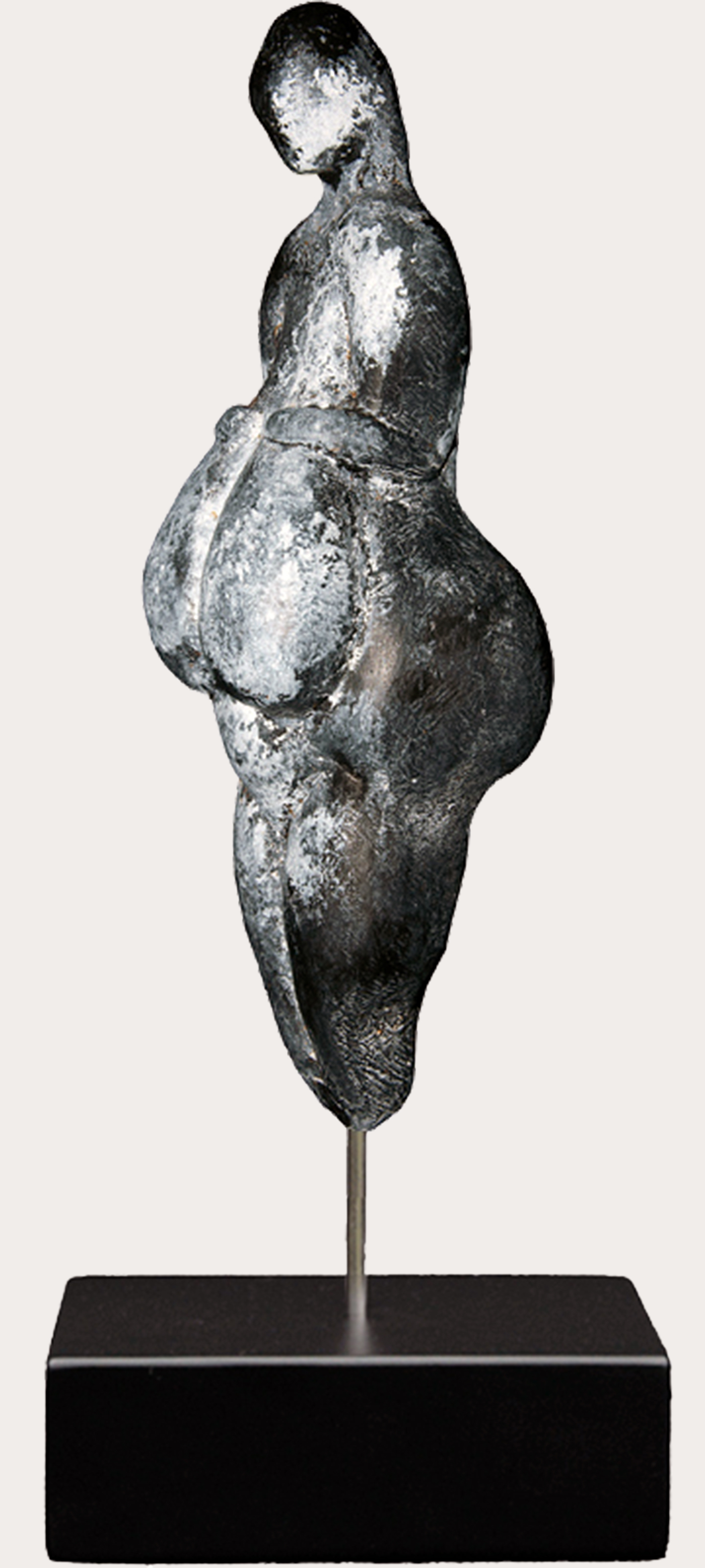


* If you require a unique combination of Sculptures and/or Prints send us the product codes using the contact form.
These sculptures were originally commissioned by the British Museum in London for the 2013 exhibition 'Ice Age Art: Arrival of the Modern Mind'. The sculptures - in bronze and plaster - are of limited editions of 100 and 250 respectively.

This standing human figure with a lion’s head was originally sculpted from mammoth ivory. The stance and muscularity of the shoulders suggest a man standing on alert with arms to his sides.
The left upper arm is marked with incisions which might represent tattoos or scarring. The head faces forward in an alert stare emphasised by a powerful jaw line and upright ears. Is this a man wearing a lion headdress, or is it a mythical or supernatural being? The Lion Man of Hohlenstein-Stadel, where it was discovered in a cave in the Swabian Jura in 1939, and also known as the Löwenmensch figurine, has posed many questions.
For example, why would a Palaeolithic stone age community living on the edge of subsistence, whose primary concerns were finding food and ensuring protection from predators allow someone to spend so much time creating a mythical figure? Perhaps because it manifested a relationship with the vital forces of nature in order to ensure a successful life.
- Age: 40,000 years old.
- Discovered: Stadel Cave on the Hohlenstein, Germany.
- Museum: Ulmer Museum, Ulm, Germany.
- Actual size: 28.1 cms tall; 6.3 cms wide; 5.9 cms thick.
- Sculpture: Limited Edition of 250.
- Artist: Peter Lyell Robinson, Bradshaw Foundation.
- Medium: Plaster, hand-painted with natural pigment.
- Stainless steel, tulip wood base.
- Sculpture dimensions: 24 cms tall [overall 28cms]; 6 cms wide; 5 cms thick.
Price inclusive of postage and packaging
Product code: LMANFIG001

The Willendorf figurine is probably the most famous prehistoric sculpture in the world. Found near the fireplace of an open air camp site, this nude sculpted from limestone and coloured with red ochre has become the stereotype for Ice Age female figures so often inappropriately referred to as ‘Venuses’ . In fact, she is exceptional.
Shown standing with knees together and feet apart, her bowed head is decorated to suggest what might be a fur hat or a braided hairstyle. She has no face but seems to look towards her right breast. Her shoulders are small above thin arms, which bend at her waist so the hands rest on top of her heavy breasts. She wears bracelets on her wrists. Her stomach is heavy, punctuated with a navel and overhangs a prominent sexual triangle above strong thighs. On the back, a horizontal groove at top of the thighs may have been a means of supporting the figure against an angular rock so that she could be displayed standing. Her lower legs are disproportionately short and she has no feet but these may have lost due to ancient damage. From the back, her well rounded buttocks appear flattened and pushed upwards which, in frontal and outline view, gives soft three dimensional curves to her full figure.
Variously interpreted as obese, pregnant or both, there is great realism in this sculpture. Unlike a classical representation of Venus, Willendorf does not try to veil her nudity with gestures which only serve to emphasise an erotic sexuality. Her power and charm are not a tease but are presented as a matter of quite ordinary fact but we have no idea what this meant to the original owners.
- 25,000 years old.
- Discovered: 7 August 1908 by Josef Szombathy near Willendorf, Austria.
- Museum: Naturhistorisches Museum, Vienna, Austria.
- Actual size: 10.6 cms tall; 5.7 cms wide; 4.5 cms thick.
- Sculpture: Limited Edition of 250.
- Artist: Peter Lyell Robinson, Bradshaw Foundation.
- Medium: Plaster, hand-painted with natural pigment.
- Stainless steel, tulip wood base.
- Sculpture dimensions: 13 cms tall [overall 19 cms]; 7 cms wide; 6 cms thick.
Price inclusive of postage and packaging
Product code: WILLEN008

This carving is the oldest known sculpture of a horse. Sculpted from mammoth ivory it is part of an originally more rounded representation with longer legs and tail. The head is complete and shows the engraved mouth, nostrils and eyes. The ears are alert and the neck arched. The mane, back and sides are marked with crossed diagonal incisions. Is this a stallion trying to impress a mare or a horse arching and kicking backwards against a predator?
- Age: 14,000 years old.
- Discovered: La Madeleine cave near Tursac, in the Dordogne département of South-Western France.
- Museum: Musée d’Archéologie Nationale, St Germain-en-Laye, Paris, France.
- Actual size: 10.5 cms long.
- Sculpture: Limited Edition of 250.
- Artist: Peter Lyell Robinson, Bradshaw Foundation.
- Medium: Plaster, hand-painted with natural pigment.
- Stainless steel, tulip wood base.
- Sculpture dimensions: 9.5 cms tall [overall 16 cms]; 12 cms wide; 4.5 cms thick.
Price inclusive of postage and packaging
Product code: VOGHOR002

Carved from mammoth ivory, this sculpture is one of the taller female figurines of Ice Age art. Found beside an excavated camp fire near the top of the deposits in the Cave of Rideaux, the figure was damaged on the front by a blow from a pickaxe and is reconstructed in this sculpture. The lozenge shaped outline of the figure encompasses a small round head with no face. The neck and shoulders are well defined and thin arms bend round to rest above the large pendulous breasts which cover a slight but prominent stomach and rest against huge buttocks. The thighs are large and curve into the knees below which the lower legs are vestigial. On the back, engraved vertical lines hang from a horizontal line below the buttocks, which may represent an apron.
The characteristics of the Lespugue figurine have been interpreted as indicative of obesity and or pregnancy by those who wish to see the sculpture as a realistic representation. However, should we only be looking for realism or, is this an intellectual image in which the mind’s eye has emphasised the meaningful aspects of this woman’s body? Is this a reflection on the origins and nourishment of life rather than simply the female form?
- Age: 24,000 - 22,000 years old.
- Discovered: Grottes de Rideaux, Lespugue, Haute-Garonne, France.
- Museum: Musée de l’Homme, Paris, France.
- Actual size: 14.4 cms high; c.6.4 cms wide; c.3.5 cms thick.
- Sculpture: Limited Edition of 250.
- Artist: Peter Lyell Robinson, Bradshaw Foundation.
- Medium: Plaster, hand-painted with natural pigment.
- Stainless steel, tulip wood base.
- Sculpture dimensions: 14 cms tall [overall 28cms]; 6 cms wide; 4 cms thick.
Price inclusive of postage and packaging
Product code: LESFIG003

Found in 1894, this beautiful portrait head of a woman is justifiably one of the most famous works of Ice Age art. Made from the core of ivory from a mammoth tusk it is an accomplished piece of sculpture. Scraped and polished in outline, the eyebrows, nose and chin are carved in relief and the pupils in the eyes are marked by little holes. The hairstyle has been created by incised horizontal and vertical lines which form a pattern of squares. This is perhaps indicative of braiding although when the figure was first discovered it was thought to be a decorative hood giving rise to the title 'Dame à la capuche'. The head is sometimes shown on a body reconstructed from a number of broken fragments but actually appears to be a complete work.
- Age: 23,000 years old.
- Discovered: Grotte du Pape, Brassempouy, Landes, France.
- Museum: Musée des Antiquités Nationales, St Germain-en-Laye, Paris.
- Actual size: 3.65 cms high.
- Sculpture: Limited Edition of 250.
- Artist: Peter Lyell Robinson, Bradshaw Foundation.
- Medium: Plaster, hand-painted with natural pigment.
- Stainless steel & wooden base.
- Sculpture dimensions: 8.5 cms tall [overall 19 cms]; 4.5 cms wide; 5.5 cms thick.
Price inclusive of postage and packaging
Product code: BPOUYHEAD004

To shape an entire bison from the palmate section of a reindeer antler the sculptor has ingeniously shown the animal turning to lick its side. The head and neck are formed in low relief against the body. Their exquisite details bring the figure to life. The sculpture may have been part of a spear thrower.
- Age: 14,000 years old.
- Discovered: La Madeleine cave near Tursac, in the Dordogne département of South-Western France.
- Museum: Musée d’Archéologie Nationale, St Germain-en-Laye, Paris, France.
- Actual size: 10.5 cms long.
- Sculpture: Limited Edition of 250.
- Artist: Peter Lyell Robinson, Bradshaw Foundation.
- Medium: Plaster, hand-painted with natural pigment.
- Stainless steel, tulip wood base.
- Sculpture dimensions: 9.5 cms tall [overall 16 cms]; 12 cms wide; 4.5 cms thick.
Price inclusive of postage and packaging
Product code: MBISONR005

Many of the sculptures of animals in Ice Age art are depicted in still positions. The Crouching Lion from Pavlov I is a fine exception. Discovered in 1952 close to the Upper Palaeolithic archaeological site near the village of Dolní Věstonice, Moravia in the Czech Republic, this sculpture carved from mammoth ivory depicts a lion in motion; crouching or, more likely, leaping. Also known as the Pavlov Lion, it was discovered in a pile of bones next to a wolf skull and just metres from a hearth. Most of the lion’s outline has been cut and rounded, but parts have been left unworked.
- Age: 29,000 years old.
- Discovered: Dolní Věstonice, Moravia in the Czech Republic.
- Museum: Archaeological Institute of the Czech Academy of Sciences, Brno.
- Actual size: 21.5 cms long.
- Sculpture: Limited Edition of 250.
- Artist: Peter Lyell Robinson, Bradshaw Foundation.
- Medium: Plaster, hand-painted with natural pigment.
- Stainless steel & wooden base.
- Sculpture dimensions: 4 cms tall [overall 16 cms]; 12 cms long; 2.5 cms thick.
Price inclusive of postage and packaging
Product code: LEAPLIONR006

Originally carved out of amphibolite 32,000 years ago, and measuring 7.2 cms in height, this exquisite piece has now been cast in solid bronze, in a limited edition of 100. The bronze 'dancing' figurine of Galgenburg stands on a black metal pin set in a wooden base. [Overall height 15cms].
One of the oldest human sculptures in the world, this figure of a nude woman dancing was found broken in eight pieces near a camp fire on an open air site. Made with great skill and artistry from an attractive pebble of blackish green amphibolite the figure is worked in relief on the front and is flat on the back.
The right arm is held above the head and her breast hangs beneath. The left arm curves out from the body, shoulder slightly forward, hand resting on the thigh of the left leg which also curves outwards, knee slightly bent. The head is poised, slightly square and lacking a face. The pose suggests movement in a dance and the figurine is often called ‘Fanny’ after one of Austria’s prima ballerinas. Such movement is exceptional among early human sculptures which more often have an immobile stance. Was she enjoying herself or participating in a ritual celebration?
- Age: c. 36,000 years.
- Discovered: Stratzing, Krems-Rehberg, Lower Austria.
- Museum: Naturhistorisches Museum Vienna, Austria.
- Actual size: Height 7.2 centimetres.
- Sculpture: Limited Edition of 100.
- Artist: Peter Lyell Robinson, Bradshaw Foundation.
- Medium: Bronze.
- Stainless steel & wooden base.
- Sculpture dimensions: 7 cms tall; 2.7 cms long; 0.5 cms thick.
Price inclusive of postage and packaging
Product code: GALFIG007
